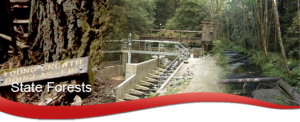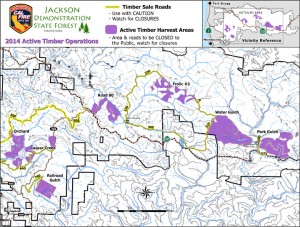Jackson Demonstration State Forest Recreation Task Force Survey Results
On March 14th 2014 Cal Fire presented the “Jackson Demonstration State Forest Recreation Task Force Survey Results”
 Mendocino Coast Cyclists and other local recreation enthusiasts made the journey from the Mendocino coast to The Cal Fire headquarters at the Howard Forest Fire Station Emergency Command Center to listen as the Jackson Demonstration State Forest Recreation Task Force Survey Results were presented to the public.
Mendocino Coast Cyclists and other local recreation enthusiasts made the journey from the Mendocino coast to The Cal Fire headquarters at the Howard Forest Fire Station Emergency Command Center to listen as the Jackson Demonstration State Forest Recreation Task Force Survey Results were presented to the public.
This survey is another step in the long process of integrating recreation into the other uses of the forest. The information presented is intended to assist in this process with better awareness of what the actual users want and do not want in the forest.
Executive Summary

Personnel from CAL FIRE along with local stakeholders recognized the need for a new recreation management plan to guide use of the forest over the next decade. As a component of these planning efforts, a contract with a researcher at California Polytechnic State University was initiated to conduct a recreation visitor survey during summer 2013.
The visitor survey was developed in collaboration with Jackson Demonstration State Forest (JDSF) managers and with input from members of the Recreation Task Force and the Jackson Advisory Group (JAG). Data were collected on 10 randomly selected weekdays and 20 weekend days during July, August, and September 2013. Researchers used iPads and the survey application Quicktap Survey to administer the study. A total of 402 subjects completed the questionnaire in three general regions of the forest as defined by CAL FIRE.
The subjects were mostly married, white, with at least some college education, about 46 years old, visiting the forest with family, friends, or family and friends. The average group size was about five people. More than 50% of the subjects were Mendocino County residents. Primary recreational activities on the forest included camping, hiking, horseback riding, mountain biking, firearms target shooting, and picnicking. 
The findings suggested that visitors are satisfied with most facilities and services and that overall conditions are generally acceptable. However, results throughout the survey indicated the need for signage, maintenance of bathrooms, improvements to trail systems, and additional personal and non-personal information services. Support for renovation of the Red School House and a volunteer program was evident. The subjects also desired designated areas for shooting firearms and archery, changes in the camping reservation system, and access to roads.
Crowding on weekends is somewhat of an issue and recreation conflict between equestrians and hikers needs to be monitored.
Sources of information about the forest have normally come from personal sources; however, visitors also indicated that they obtain information on the Internet.
The fmdings of the study provide a basis for a new recreation management plan and highlight areas of concern in addition to those activities, services, and facilities that CAL FIRE is managing well. As demographics in California change and recreation activities evolve, JDSF management will need to continue monitoring its recreation policies, decision-making, planning, and strategies to manage the complexities of the forest while meeting the visitors’ recreation needs and the forest management mandate of this valuable resource.

